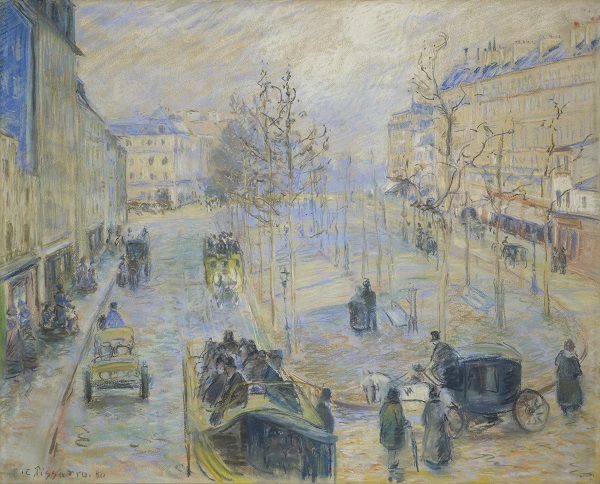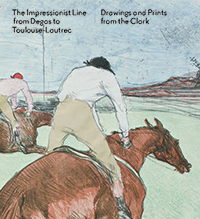
NOVEMBER 5, 2017–JANUARY 7, 2018
IMPRESSIONISM ON PAPER, 1874–1886
Camille Pissarro (French, 1830–1903)
Boulevard Rochechouart, 1880
Pastel on paper
Clark Art Institute, 1996.5
During the late nineteenth century, many French art critics argued that prints and drawings could bring the viewer closer to the inception of an artist’s creative process and closer to the pulse of modern life. Historically, the rigorous instructional program at the state-sponsored Académie des Beaux-Arts revolved around students’ mastery of drawing the human figure, while color was considered secondary. A frequent complaint lodged against the Impressionists by their detractors was a lack of “drawing”—the definable, exact rendering of space and form. Positive critical reviews, on the other hand, suggested that the Impressionist line embodied modernity.
Long overshadowed by oil paintings, the prints and drawings that made up nearly half of the artworks on view in the eight Impressionist exhibitions held in Paris between 1874 and 1886 reveal artistic experimentation and technical innovation. Whether constructed with careful delineation or improvisational, sketchy strokes, Impressionist works on paper depicted everyday life in Paris, the suburbs, and the countryside, capturing glimpses of people at leisure and dancers, agricultural laborers, jockeys and racehorses, and stage performers in their working environments. These images of modern life illustrate the Impressionists’ diverse approaches to drawing and demonstrate a shared enthusiasm for new artistic media and technologies.
Following increased attention to the graphic arts in the Impressionist exhibition of 1879, Edgar Degas, Mary Cassatt, Félix Bracquemond, and Camille Pissarro began to consider a publication devoted to prints. They planned to call the journal Le Jour et la Nuit (Day and Night) and to illustrate it with original black-and-white etchings. Sharing access to Degas’s studio and small etching press, the artists experimented with multiple processes, producing technically complex works that appear speedily executed and spontaneous. Though Le Jour et la Nuit never came to fruition, preparations for the publication sparked the participants’ interests in printmaking processes. Whereas Degas explored the monotype, which he described as “drawings made with greasy ink and put through a press,” Cassatt and Pissarro continued to experiment with intricate soft-ground, aquatint, and, eventually, color etching techniques.
A fully illustrated catalogue, edited by Jay A. Clarke, accompanies the exhibition. The 160-page catalogue includes essays by Mary Weaver Chapin, Jay A. Clarke, Anne Higonnet, Richard Kendall, and Alastair Wright. The catalogue is published by the Clark and distributed by Yale University Press. Call the Museum Store at 413 458 0520 to order.


